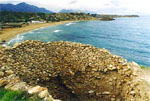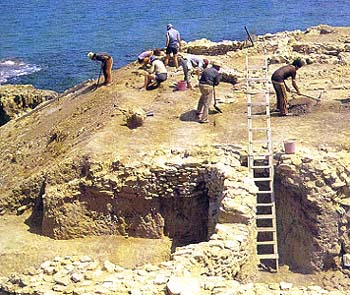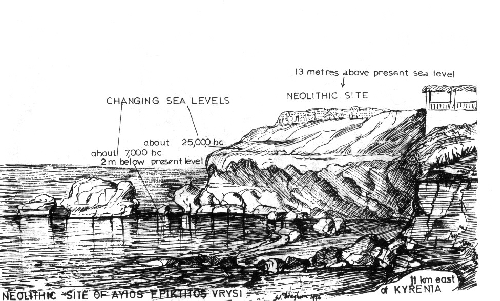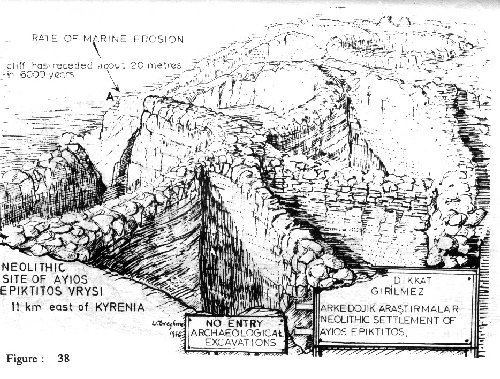[ Vrysi ] [ Troulli ] [ Vouni ]
- Ayios Epiktitos, Vrysi archaeological site 5250-3000B.C.
Archaeological Site "Ayios Epiktitos -
Vrysi", is located on a rocky cliff 6.5 miles, east of military occupied
Kyrenia within the boundaries of occupied Ayios Epiktitos village. It took the
name Vrysi because of a natural spring located in the area
(Vrysi in Greek means tap, or small water fountain/ spring).

Vrysi site - South East view- click to enlarge
After Chirokitia ancient settlement in Larnaca, it is one of
the most Ancient Archaeological Site ever found in Cyprus dated as far back as
5,250 years B.C.
The importance of the site is because we have the first
evidence of handmade Pottery produced in Cyprus from the last period of
Neolithic Age II (3500-3000 BC). We also found proof of the first Textile
making.
Moreover, there were found remains of grapes, olives, and it seems that Wine-making
was also known. Moreover, Golden earrings, and other golden artifacts,
indicate that the ancient village had a high level of culture, far more advanced
than the Chirokitia settlement.

Excavation process at occupied Vrysi site, in Occupied Agios Epiktitos
village, Kyrenia district, CYPRUS. Click to enlarge.
A preliminary investigation was made in 1969, and much use was made of aerial photography in planning the excavations, which began in 1972 and continued in 1973. A team of scientists and students from the universities of Glasgow and Birmingham were engaged in the digging under the supervision of the Cyprus government. In all, there would be some 30 workers at a time, all very busy in the long hot summer, excavating the soil which covered the ancient houses to a depth of 7 meters.
The barbaric Turkish invasion in July 20 1974
interrupted the excavation process forcing all Greek-Cypriots out of their
homes.
Ayios Epiktitos and Vrysi archaeological Site are under Turkish military
occupation since then.
The Turks, masters by now in stealing, appreciated the importance of this archaeological site inside Ayios Epiktitos. They continued the excavations and managed to extract 62,000 pieces of artifacts from Vrysi site. They displayed them inside the castle of Kyrenia along with the Ancient Ship of Kyrenia discovered by Andreas Kariolou in 1967.

This is a view of the cliff and it shows how marine
erosion has undercut the cliff which will ultimately destroy this important
excavation. It refers to the many changes of sea level that have occurred in the
last 10,000 years.

This is a sketch showing Vrysi archaeological site in Ayios
Epiktitos as it looks today.

Ayios Epiktitos Vrysi - click to enlarge
